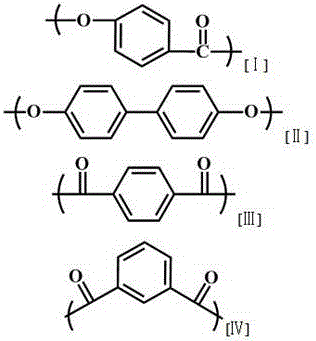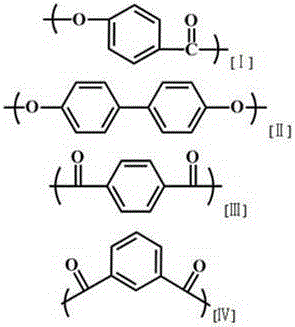Liquid crystal polyester and its molded composition and use
A molding composition, liquid crystal polyester technology, applied in liquid crystal materials, chemical instruments and methods, etc., can solve problems such as mold filling dissatisfaction, influence of resin fluidity, and application of liquid crystal polymers
- Summary
- Abstract
- Description
- Claims
- Application Information
AI Technical Summary
Problems solved by technology
Method used
Image
Examples
Embodiment 1
[0066] Add the following monomer raw materials, acylating agent and catalyst to the polymerization reaction device equipped with agitator, reflux condenser, monomer feeding port, nitrogen inlet, thermometer and torque sensor.
[0067] (I) p-hydroxybenzoic acid 1180 g (60 mol %) HBA
[0068] (Ⅱ) 4,4'-biphenol 530.1 g (20mol %) BP
[0069] (Ⅲ) Terephthalic acid 402.1 g (17mol%) TA
[0070] (IV) Isophthalic acid 70.9 g (3 mol%) IA
[0071] Acylating agent: acetic anhydride 1527 g
[0072] Catalyst: Magnesium acetate 115 mg
[0073] After the feeding is completed, completely replace the atmosphere in the reaction vessel with nitrogen, raise the temperature of the reaction system to 150°C under the protection of nitrogen, and keep the nitrogen pressure at 0.2MPa, and maintain this temperature for reflux for 2 hours to carry out the acylation reaction; acylation After the reaction is over, turn on the vacuum pump to reduce the pressure in the reactor to 10KPa-30KPa, and quickly ...
Embodiment 2-5
[0074] Embodiment 2-5: according to the formula of table 1, after the acylation reaction finishes, open vacuum pump and the pressure in the reactor is decompressed to 10KPa-30KPa, discharge acetic acid and unreacted acetic anhydride molecule rapidly from the rectifying column, to meet the rapid The process of heating requires that when the amount of acetic acid received reaches more than 50% of the theoretical value, the temperature should be raised rapidly to 210°C, the reduced pressure condition should be maintained and the temperature of the reaction system should be raised to the highest temperature of 370°C within 6 hours, during which the acetic acid, especially Phenol and other by-product small molecules that cause molecular chain rearrangement and branching are then decompressed to 60KPa in 30 minutes; the rest are the same as in Example 1; the melting point, melt viscosity, and storage modulus release rate of the liquid crystal polyester are rod-shaped Fluid lengths ar...
Embodiment 6-12
[0075] Embodiment 6-12: according to the formula of table 1, after the acylation reaction finishes, open vacuum pump and the pressure in the reactor is decompressed to 10KPa-30KPa, discharge acetic acid and unreacted acetic anhydride molecule rapidly from the rectifying column, in order to satisfy rapidly The process of heating requires that when the amount of acetic acid received reaches more than 50% of the theoretical value, the temperature should be raised rapidly to 220°C, the reduced pressure condition should be maintained and the temperature of the reaction system should be raised to the highest temperature of 380°C within 6 hours, during which the acetic acid, especially Phenol and other by-product small molecules that cause molecular chain rearrangement and branching are then decompressed to 70KPa in 30 minutes; the rest are the same as in Example 1; the melting point, melt viscosity, and storage modulus release rate of the liquid crystal polyester are rod-shaped Fluid...
PUM
 Login to View More
Login to View More Abstract
Description
Claims
Application Information
 Login to View More
Login to View More - R&D
- Intellectual Property
- Life Sciences
- Materials
- Tech Scout
- Unparalleled Data Quality
- Higher Quality Content
- 60% Fewer Hallucinations
Browse by: Latest US Patents, China's latest patents, Technical Efficacy Thesaurus, Application Domain, Technology Topic, Popular Technical Reports.
© 2025 PatSnap. All rights reserved.Legal|Privacy policy|Modern Slavery Act Transparency Statement|Sitemap|About US| Contact US: help@patsnap.com



